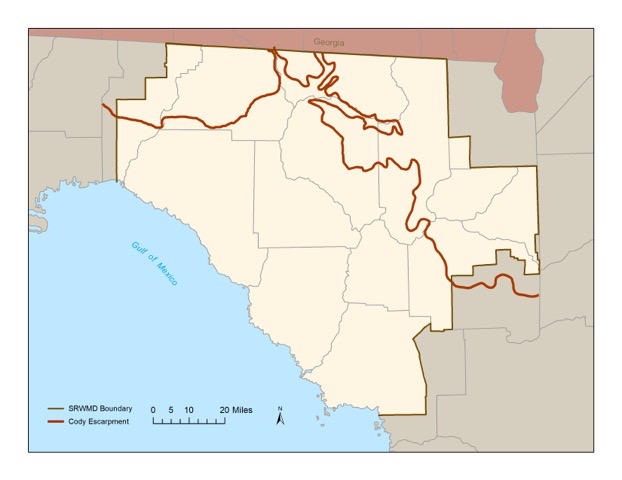Kenzie James
news@greenepublishing.com
Suwannee County is home to numerous rivers and freshwater springs, and there is a unique geographical feature that shows how the bodies of water are all connected.
The Cody Escarpment, or Cody Scarp, is a geomorphologic feature that approximates an ancient shoreline of Florida, according to the Suwannee River Water Management District. It runs through parts of Jefferson, Madison, Suwannee and Hamilton Counties, along with other counties in North and Central Florida. The Cody Scarp is an example of karst topography, which means the scarp is made of soluble rocks such as limestone, marble and gypsum.
“A typical karst landscape forms when much of the water falling on the surface interacts with and enters the subsurface through cracks, fractures and holes that have been dissolved into the bedrock,” the National Park Service said.
The Florida Department of Environmental Protection said the Cody Scarp outlines the ancient early Pliestocene shoreline of Florida during the interglacial periods, when the sea level was higher. As the sea level receded, the cliff of the scarp was formed by erosion.
“[The Cody Scarp] marks the shift in geology between the flat former seabed to the south and the hilly, river-sculpted, clay-dominated Tallahassee Hills to the north,” the Florida Natural Areas Inventory said.
The rivers of Suwannee County cross the Cody Scarp and enter this subsurface, becoming underground rivers until they emerge as springs downstream. While underground, many of the rivers become part of the Florida Aquifer system. Suwannee County is home to 11 rivers: Alapaha, Aucilla, Econfina, Fenholloway, Ichetucknee, Santa Fe, Steinhatchee, Suwannee, Waccasassa, Wacissa and Withlacoochee. All of the rivers go underground at the scarp except for one- the Suwannee River. As the rivers emerge back to the surface, they become the springs in Suwannee County: Columbia, Devil's Ear, Falmouth, Fanning, Hornsby, Ichetucknee, Lafayette Blue, Madison, Manatee, Peacock, Poe, Treehouse, Troy and Wacissa. Many of the springs are found near cave entrances, where the water resurfaces from traveling underground.
“At O'Leno State Park the entire Santa Fe River is swallowed by a sink as the river crosses the Cody Scarp, then travels underground through a network of cave passages for over three miles before re-emerging at a spring in River Rise Preserve State Park,” the Suwannee River Water Management District said.
Each river and spring has a park or state park that offers activities for guests to explore the water and see the effects of the Cody Scarp at each spring. Many of the parks' activities include hiking, biking, horseback riding, kayaking, tubing, scuba diving and swimming. The cool waters of the springs average 70 degrees Fahrenheit year-round, according to the Suwannee River Water Management District, making these water activities appealing to many families who visit during hot summer days.

